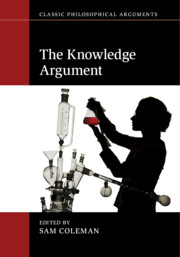Book contents
- The Knowledge Argument
- Classic Philosophical Arguments
- The Knowledge Argument
- Copyright page
- Contents
- Contributors
- Introduction: The Enduring Significance of Jackson’s Knowledge Argument
- 1 The Knowledge Argument Is an Argument about Knowledge
- 2 There’s Nothing about Mary
- 3 Acquaintance, Parsimony, and Epiphenomenalism
- 4 Acquaintance and Phenomenal Concepts
- 5 The Knowledge Argument Meets Representationalism about Colour Experience
- 6 The Mary-Go-Round
- 7 Concept Mastery, Social Externalism, and Mary’s New Knowledge
- 8 Mary’s Powers of Imagination
- 9 The Knowledge Argument Is Either Indefensible or Redundant
- 10 Grounding, Analysis, and Russellian Monism
- 11 Phenomenal Knowledge Why: The Explanatory Knowledge Argument against Physicalism
- 12 The Knowledge Argument and the Self
- 13 What Uninformed Mary Can Teach Us
- Bibliography
- Index
13 - What Uninformed Mary Can Teach Us
Published online by Cambridge University Press: 09 September 2019
- The Knowledge Argument
- Classic Philosophical Arguments
- The Knowledge Argument
- Copyright page
- Contents
- Contributors
- Introduction: The Enduring Significance of Jackson’s Knowledge Argument
- 1 The Knowledge Argument Is an Argument about Knowledge
- 2 There’s Nothing about Mary
- 3 Acquaintance, Parsimony, and Epiphenomenalism
- 4 Acquaintance and Phenomenal Concepts
- 5 The Knowledge Argument Meets Representationalism about Colour Experience
- 6 The Mary-Go-Round
- 7 Concept Mastery, Social Externalism, and Mary’s New Knowledge
- 8 Mary’s Powers of Imagination
- 9 The Knowledge Argument Is Either Indefensible or Redundant
- 10 Grounding, Analysis, and Russellian Monism
- 11 Phenomenal Knowledge Why: The Explanatory Knowledge Argument against Physicalism
- 12 The Knowledge Argument and the Self
- 13 What Uninformed Mary Can Teach Us
- Bibliography
- Index
Summary
We all know the story of Frank Jackson’s Mary, locked in her black and white room and released to discover a world full of color. Less well known is the story of Uninformed Mary (hereafter U-Mary). Like Jackson’s Mary, she is locked in a black and white room and has been there her entire life. Unlike Jackson’s Mary, she does not have God-like knowledge of the physical facts of color and color experience. She has various books to read but she is indifferent to those that tell her about the colors. “What are they to me?” she mutters. “Never experienced them, never will.” One day, much to her surprise, she discovers that the door to her room is unlocked and opening it, she finds herself in another black and white room with a large reclining chair in the middle, a chair of the sort one might find in a dentist’s office. She goes over and sits in it. As she does so, clamps suddenly emerge from the chair arms holding her firmly in place, and a device descends from the ceiling that covers her head. The device contains probes that penetrate her skull as it descends. These probes are positioned so that they end up in her visual cortex and so stimulate it that she has a vivid hallucinatory experience of a red patch, an orange patch and a green patch on a white wall. A voice tells her to pay attention to the colors of the patches and informs her that the far left-hand patch is red, the middle one orange and the one on the right green. She is then told that she will be released into the outside world if she answers one question: Is red is more similar to orange or to green?
Information
- Type
- Chapter
- Information
- The Knowledge Argument , pp. 269 - 280Publisher: Cambridge University PressPrint publication year: 2019
Accessibility standard: Unknown
Why this information is here
This section outlines the accessibility features of this content - including support for screen readers, full keyboard navigation and high-contrast display options. This may not be relevant for you.Accessibility Information
- 2
- Cited by
